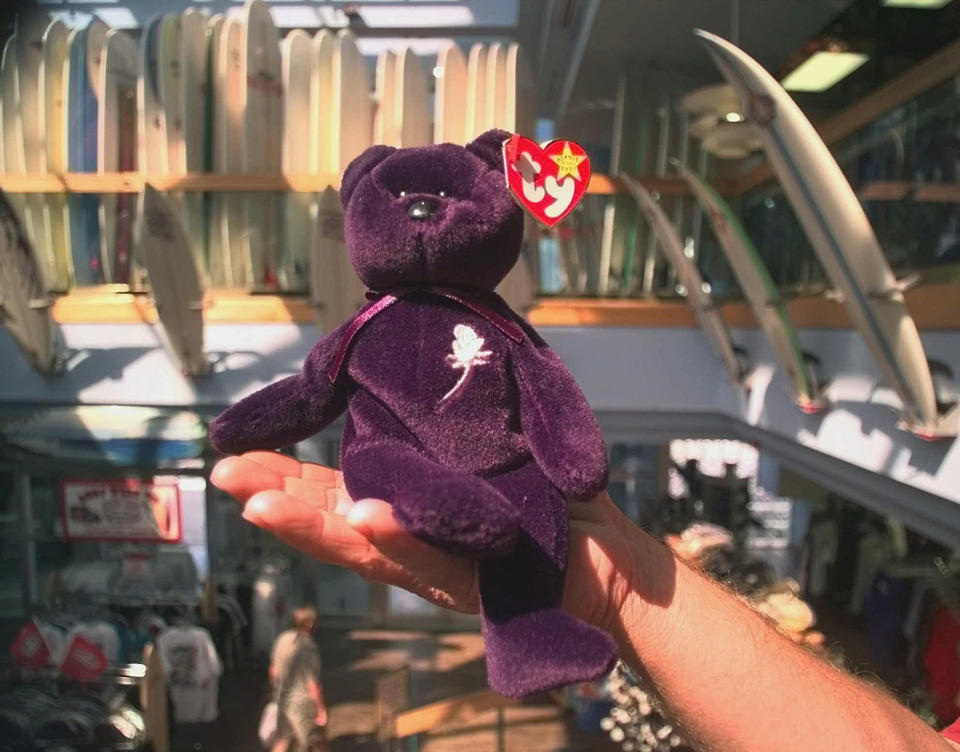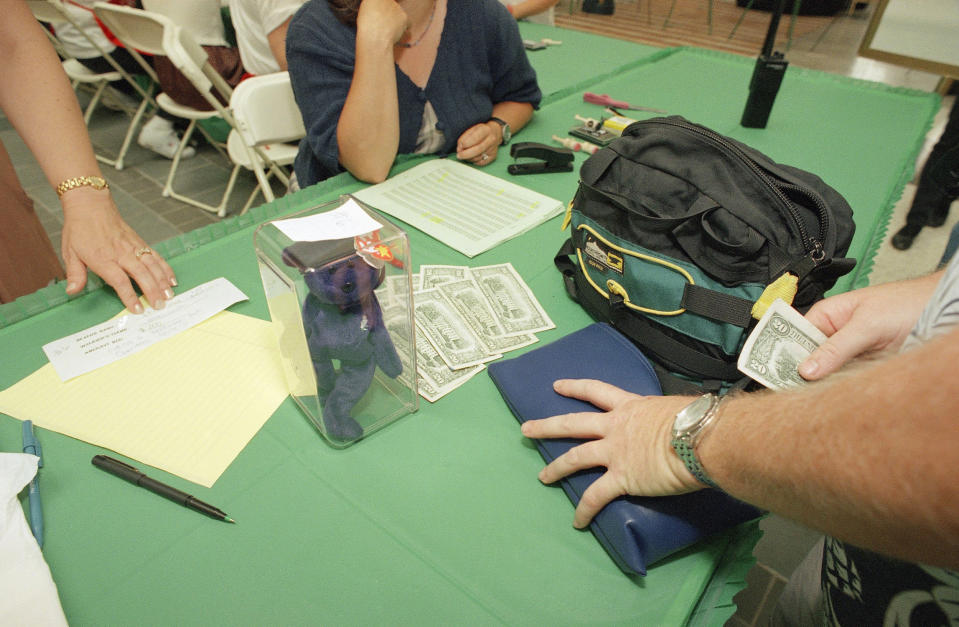What Is Your Princess Diana Beanie Baby Worth? Inside The Legend
- Oops!Something went wrong.Please try again later.
As a new mom in the ‘90s, Gretchen LeMay turned the Beanie Baby market into her side hustle. She regularly monitored drops at Hallmark stores, buying and selling the most in-demand plushies.
But one of the most coveted Beanie Babies was also the one LeMay would never sell: “Princess,” a purple bear released two month after Princess Diana died, commemorating the late Princess of Wales.
“Diana is my favorite royal. When that Beanie came out, I literally fought an old lady to get it,” said LeMay, 50, of Boise, Idaho, recalling the eventful trip to a Hallmark store in Idaho. “She was going for it, but because I was younger and faster, I got it first. If it were anything else, I would have relented and said, ‘Oh, no, you go ahead.’ But I was like, ‘This one’s mine.’”
Ty Inc., the producer of Beanie Babies, announced it was creating a royal-themed doll in October 1997, with proceeds going to Diana, Princess of Wales Memorial Fund.
The toy had dark purple fur that evoked royalty and a little white rose on the upper left corner. A little poem on the tag described Diana’s short but influential life: “Like an angel she came from heaven above; she shared her compassion, her pain, her love; she only stayed with us long enough to teach the world to share, to give, to reach.”
LeMay felt a connection to Diana. “I guess I identified with her on some level. She had an ability to make you feel like she knew you, even though she didn’t. When she died, it was like the first time a famous person’s death affected me. I bawled,” she said. “My husband said, ‘You’re acting insane.’ I said, ‘You don’t understand. It’s Diana.’”

Michelle Lederman, a 42-year-old from Queens, didn’t have to fight for her Princess Beanie Baby. At the time, Lederman was in high school. The father of her future husband was the owner of a Hallmark Store in Brooklyn. He set one aside for her, which joined her collection of hundreds of Beanie Beanies.
Related video: Insiders reflect on the death of Princess Diana 25 years later
For Lederman, the allure was more about the collection, and less about Diana. “I am a completist. I need to have the set, much to everyone’s dismay in my house,” she said.
The Princess Beanie Babies, when they came out, had a special allure of rarity — and still do to this day.
“The biggest myth is that Princess is that she’s unusually valuable. But there were so many made that they are never going to be rare,” Leon Schlossberg, who runs TyCollector.com along with his daughter, Sondra, told TODAY.
Princess’ reputation as a doll had a lot to do with the unusual rollout. At the time, Beanie Babies were only sold through gift stores, like Hallmark Stores. Ty, as Schlossberg explained, needed to get permission from the Diana, Princess of Wales Memorial Fund to create the toy. With permission granted too close to Christmas to sate demand for the holiday rush. Ty told retailers they were limited to ordering 12 at a time.
“The retailers, in conjunction with the media misunderstanding the limit on the initial order, convinced the public that it was going to be a limited edition item,” Schlossberg said. In fact, millions were produced the following year.
This led to a frenzy, with prices rising on the secondary market and auctions. An article from the Washington Post at the time said competing prices at one mall had their Princess dolls listed at $350 and $400, rather than the $5 to $7 ticket value.
Tara Thomas Canady, a 33-year-old from Arkansas, said she wanted a Princess doll because it seemed "rare." Her grandparents spent about $200 on the Beanie Baby, which she now calls "absolutely insane." She told TODAY, "I wouldn’t spend that kind of money on a stuffed animal for my son but they had a problem with not telling no when I wanted something."
Writer Sonia Saraiya of New York remembers buying an overpriced Beanie Baby with her mom and sister. “The Princess Diana one was the one I spent the most money on — $25,” she said. “You didn’t cuddle with your Beanie Baby, but it was important to have it.”
Not too long afterwards, Saraya wondered why she bought it. Looking back, though, Saraya believes her purchase was the result of a “specific confluence of feelings,” spurred by the Beanie Baby craze which kicked off in the early '90s, and the very real grief of Diana’s death.
“There was a psychological aspect to it. People felt so bad. Everybody loved her. They just wanted to do something but they didn’t know what. And here comes Ty with this Beanie Baby you can buy and remember her forever,” Schlossberg said.
The result of the strange rollout, combined with the real emotional pull, meant the Princess dolls seemed valuable, but they weren’t.
“The idea that you have something that’s rare is appealing,” Zac Bissonette, author of “The Great Beanie Baby Bubble,” a study of Ty Warner’s stuffed animal empire, told TODAY. Bissonette said there are Beanie Babies that are genuinely rare, like the wingless version of the Quacker doll, but are less buzzy. “You don’t really hear about those because if you had it, you’d already know,” Bissonette said.

Still, even though there were millions made, the bears were considered valuable preemptively by many owners. Growing up, Jill Christie of West Virginia didn’t quite understand why she could play with all the Beanie Babies — except the purple bear, up on the shelf. “I found out later that she also bought a second one to keep thinking it would be worth something one day so we had one pristine and one that the two-year-old played with,” Christie said.
The toys retain a sheen of value to this day, largely thanks to asking prices on eBay, which range from the single digits to the high six figures. There are small discrepancies between listings, with some claiming to be “rare” and therefore more valuable for having PVC pellets as opposed to polyethylene pellets. One listing at $500K markets itself as the “holy grail” for collectors, saying it’s one of 20 made in Indonesia. Others are listed for $7.50, not far from the price in 1997.
Schlossberg said the most a Princess Beanie Baby usually goes for is $170, even if asking prices say otherwise. “Prices on eBay for Princess are bogus,” he said. “If you have a Princess and you put her up for auction and the motion good for her is $15 or $20 dollars, then that’s what she’s worth literally, right? Because that’s the most anybody’s willing to pay,” he said.
He said headlines about Princess’ exorbitant prices are misleading. “The more people see the prices, the more people think it’s valuable. It gets a lot of people’s hopes up, because a lot of people have a Princess,” Schlossberg said. “It’s a game of psychological warfare against buyers who don’t know any better.”
The myth of this particular Beanie Baby’s value is strong enough for Anna Peele, a 34-year-old living in Manhattan, to hold on to her two Princess Beanie Babies through these years. Peele kept her collection of 75-or-so Beanie Babies intact, until her husband finally convinced her they would not net a fortune — but she has yet to get rid of her two Princesses.
“I haven’t really considered selling (them) because I guess I must still somehow think it will be worth actual money one day, which is a borderline-psychotic belief,” Peele said.
And, years later, the toy’s cultural importance — and potential dollar sign — was strong enough for 26-year-old Catarina Carosa of Rochester, New York to return to a consignment store in Buffalo, New York an hour after seeing the Beanie Baby, because she decided she had to have it.
Born in 1995, Carosa is too young to remember a world in which Diana was alive. But the cultural power of this particular toy resonated. “I still need it because of the historical aspect of how big and important Diana’s death was,” she said.
At a time when people are figuring out where to donate their Beanie Baby collections, Carosa is adding to hers. She kept it in a paper bag it came in for a while, but now it’s on her shelf, where she can see it.
Because in the end, they’re toys — meant to be interacted with. That’s why Lederman donated her collection recently to a women’s shelter. “I said, ‘Maybe you can just give them to the kids.’ They were thrilled,” she said.
CORRECTION 8/31 at 8:16 p.m.: Correctly identified Sondra Schlossberg as Leon Schlossberg's daughter. Previously she had been identified as his wife.
This article was originally published on TODAY.com


